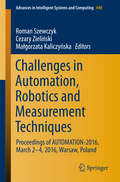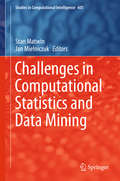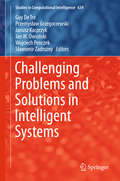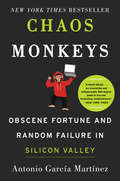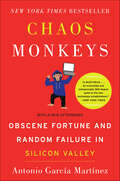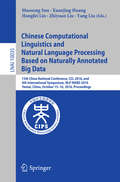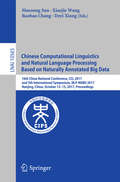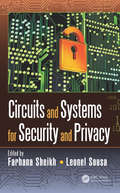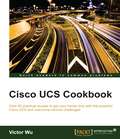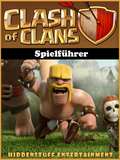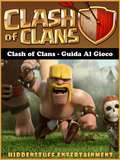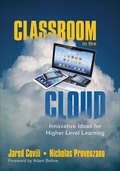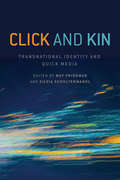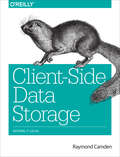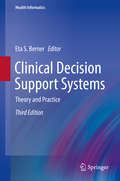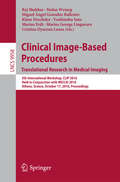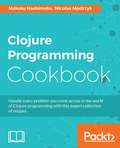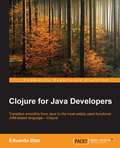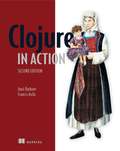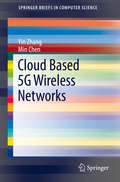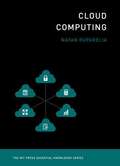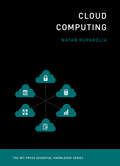- Table View
- List View
Challenges in Automation, Robotics and Measurement Techniques: Proceedings of AUTOMATION-2016, March 2-4, 2016, Warsaw, Poland (Advances in Intelligent Systems and Computing #440)
by Roman Szewczyk Małgorzata Kaliczyńska Cezary ZielińskiThisbook presents the set of papers accepted for presentation at the InternationalConference Automation, held in Warsaw, 2-4March of 2016. It presents the research results presented by top experts in thefields of industrial automation, control, robotics and measurement techniques. Eachchapter presents a thorough analysis of a specific technical problem which is usuallyfollowed by numerical analysis, simulation, and description of results ofimplementation of the solution of a real world problem. The presentedtheoretical results, practical solutions and guidelines will be valuable forboth researchers working in the area of engineering sciences and forpractitioners solving industrial problems.
Challenges in Computational Statistics and Data Mining (Studies in Computational Intelligence #605)
by Stan Matwin Jan MielniczukThis volume contains nineteen research papers belonging to the areas of computational statistics, data mining, and their applications. Those papers, all written specifically for this volume, are their authors' contributions to honour and celebrate Professor Jacek Koronacki on the occcasion of his 70th birthday. The book's related and often interconnected topics, represent Jacek Koronacki's research interests and their evolution. They also clearly indicate how close the areas of computational statistics and data mining are.
Challenging Problems and Solutions in Intelligent Systems (Studies in Computational Intelligence #634)
by Janusz Kacprzyk Sławomir Zadrożny Guy De Trė Przemysław Grzegorzewski Jan W. Owsiński Wojciech PenczekThis volume presents recent research, challenging problems and solutionsin Intelligent Systems- covering the following disciplines: artificial andcomputational intelligence, fuzzy logic and other non-classic logics,intelligent database systems, information retrieval, information fusion,intelligent search (engines), data mining, cluster analysis, unsupervisedlearning, machine learning, intelligent data analysis, (group) decision supportsystems, intelligent agents and multi-agent systems, knowledge-based systems,imprecision and uncertainty handling, electronic commerce, distributed systems,etc. The book defines a common ground for sometimes seemingly disparateproblems and addresses them by using the paradigm of broadly perceived intelligentsystems. It presents a broad panorama of a multitude of theoretical andpractical problems which have been successfully dealt with using the paradigmof intelligent computing.
Chaos Monkeys: Obscene Fortune and Random Failure in Silicon Valley
by Antonio Garcia Martinez<P>Liar's Poker meets The Social Network in an irreverent exposé of life inside the tech bubble, from industry provocateur Antonio García Martínez, a former Twitter advisor, Facebook product manager and startup founder/CEO. <P>The reality is, Silicon Valley capitalism is very simple:Investors are people with more money than time.Employees are people with more time than money.Entrepreneurs are the seductive go-between.Marketing is like sex: only losers pay for it. Imagine a chimpanzee rampaging through a datacenter powering everything from Google to Facebook. Infrastructure engineers use a software version of this "chaos monkey" to test online services' robustness--their ability to survive random failure and correct mistakes before they actually occur. Tech entrepreneurs are society's chaos monkeys, disruptors testing and transforming every aspect of our lives, from transportation (Uber) and lodging (AirBnB) to television (Netflix) and dating (Tinder). One of Silicon Valley's most audacious chaos monkeys is Antonio García Martínez. <P>After stints on Wall Street and as CEO of his own startup, García Martínez joined Facebook's nascent advertising team, turning its users' data into profit for COO Sheryl Sandberg and chairman and CEO Mark "Zuck" Zuckerberg. Forced out in the wake of an internal product war over the future of the company's monetization strategy, García Martínez eventually landed at rival Twitter. He also fathered two children with a woman he barely knew, committed lewd acts and brewed illegal beer on the Facebook campus (accidentally flooding Zuckerberg's desk), lived on a sailboat, raced sport cars on the 101, and enthusiastically pursued the life of an overpaid Silicon Valley wastrel. <P>Now, this gleeful contrarian unravels the chaotic evolution of social media and online marketing and reveals how it is invading our lives and shaping our future. Weighing in on everything from startups and credit derivatives to Big Brother and data tracking, social media monetization and digital "privacy," García Martínez shares his scathing observations and outrageous antics, taking us on a humorous, subversive tour of the fascinatingly insular tech industry. <P>Chaos Monkeys lays bare the hijinks, trade secrets, and power plays of the visionaries, grunts, sociopaths, opportunists, accidental tourists, and money cowboys who are revolutionizing our world. The question is, will we survive? <P><b>A New York Times Bestseller</b>
Chaos Monkeys: Obscene Fortune and Random Failure in Silicon Valley
by Antonio Garcia MartinezThe instant New York Times bestseller, now available in paperback and featuring a new afterword from the author—the insider's guide to the Facebook/Cambridge Analytica scandal, the inner workings of the tech world, and who really runs Silicon Valley“Incisive.... The most fun business book I have read this year.... Clearly there will be people who hate this book — which is probably one of the things that makes it such a great read.”— Andrew Ross Sorkin, New York TimesImagine a chimpanzee rampaging through a datacenter powering everything from Google to Facebook. Infrastructure engineers use a software version of this “chaos monkey” to test online services’ robustness—their ability to survive random failure and correct mistakes before they actually occur. Tech entrepreneurs are society’s chaos monkeys. One of Silicon Valley’s most audacious chaos monkeys is Antonio García Martínez.After stints on Wall Street and as CEO of his own startup, García Martínez joined Facebook’s nascent advertising team. Forced out in the wake of an internal product war over the future of the company’s monetization strategy, García Martínez eventually landed at rival Twitter. In Chaos Monkeys, this gleeful contrarian unravels the chaotic evolution of social media and online marketing and reveals how it is invading our lives and shaping our future.
Chinas Trauma – Chinas Stärke
by Paul U. UnschuldPaul U. Unschuld bietet eine kulturhistorisch begründete Analyse der politischen Geschichte Chinas der vergangenen zwei Jahrhunderte. Ein erster Teil beschreibt die verschiedenen Traumata, die dem Land im 19. und frühen 20. Jahrhundert durch ausländische Interventionen zugefügt wurden. In der zweiten Hälfte werden die Ursachen offen gelegt, die zu einem historisch einmaligen Vorgang geführt haben: dem Wiederaufstieg eines Staates, der von Staaten einer fremden, militärisch-technisch überlegenen Kultur besiegt und an den Rand des Abgrunds gebracht wurde. In seinem Geleitwort erläutert Ulrich Sendler die Bedeutung des Wissens um diese Hintergründe für ein Verständnis der Motivation und Erfolgsaussichten der Modernisierungsstrategien Chinas in einer zunehmend digitalisierten Welt.
Chinese Computational Linguistics and Natural Language Processing Based on Naturally Annotated Big Data: 15th China National Conference, CCL 2016, and 4th International Symposium, NLP-NABD 2016, Yantai, China, October 15-16, 2016, Proceedings (Lecture Notes in Computer Science #10035)
by Yang Liu Maosong Sun Zhiyuan Liu Xuanjing Huang Hongfei LinThis book constitutes the proceedings of the 15th China National Conference on Computational Linguistics, CCL 2016, and the 4th International Symposium on Natural Language Processing Based on Naturally Annotated Big Data, NLP-NABD 2016, held in Yantai City, China, in October 2016. The 29 full papers and 8 short papers presented in this volume were carefully reviewed and selected from 85 submissions. They were organized in topical sections named: semantics; machine translation; multilinguality in NLP; knowledge graph and information extraction; linguistic resource annotation and evaluation; information retrieval and question answering; text classification and summarization; social computing and sentiment analysis; and NLP applications.
Chinese Computational Linguistics and Natural Language Processing Based on Naturally Annotated Big Data: 16th China National Conference, CCL 2017, and 5th International Symposium, NLP-NABD 2017, Nanjing, China, October 13-15, 2017, Proceedings (Lecture Notes in Computer Science #10565)
by Deyi Xiong Maosong Sun Xiaojie Wang Baobao ChangThis book constitutes the proceedings of the 15th China National Conference on Computational Linguistics, CCL 2016, and the 4th International Symposium on Natural Language Processing Based on Naturally Annotated Big Data, NLP-NABD 2016, held in Yantai City, China, in October 2016. The 29 full papers and 8 short papers presented in this volume were carefully reviewed and selected from 85 submissions. They were organized in topical sections named: semantics; machine translation; multilinguality in NLP; knowledge graph and information extraction; linguistic resource annotation and evaluation; information retrieval and question answering; text classification and summarization; social computing and sentiment analysis; and NLP applications.
Circuits and Systems for Security and Privacy (Devices, Circuits, and Systems)
by Farhana Sheikh Leonel SousaCircuits and Systems for Security and Privacy begins by introducing the basic theoretical concepts and arithmetic used in algorithms for security and cryptography, and by reviewing the fundamental building blocks of cryptographic systems. It then analyzes the advantages and disadvantages of real-world implementations that not only optimize power, area, and throughput but also resist side-channel attacks. Merging the perspectives of experts from industry and academia, the book provides valuable insight and necessary background for the design of security-aware circuits and systems as well as efficient accelerators used in security applications.
Cisco UCS Cookbook
by Victor WuOver 40 practical recipes to get your hands dirty with the powerful Cisco UCS and overcome various challenges About This Book * Master the skills of minimizing cost, enabling your business to work faster by reducing cycle times for reporting and improving overall revenue * Work through hands-on recipes for efficient deployment approaches, see computing techniques, and explore new operational models with UCS * Render a better work-flow management, ensure effective monitoring, and learn new deployment paradigms for the operational infrastructure with the help of this book Who This Book Is For This book is for competent system/network or storage administrators who are working with Cisco UCS, but now want to learn new ways to compute UCS. What You Will Learn * Familiarize yourself with information on the latest information on memory management practices, virtualization architectures, and the specific technical advantages of UCS * Get a concrete understanding of integrating processes and techniques to ensure effective convergence of LAN/SAN * Get to know the best practices of Cisco UCS, EMC Storage, and VMware vSphere * Master migrating data from other band servers or Blade to Cisco UCS * Comprehend how to replicate and back up UCS to remote sites UCS * Assimilate innovative techniques to deploy UCS to leverage its full potential * Gather information on installing and configuring automatic and manual Pinning * Discover ways to integrate a system in Cisco UCS In Detail Cisco Unified Computing System (UCS) is a data center server platform that is used for computing, deploying, and storing resources in data center environments. This cookbook aims to teach you about various tasks you can implement to improve your existing method of configuring and deploying UCS. You will start by learning how to upgrade your firmware on Brocade and Cisco Fibre Channel Switch and will move on to enhance your knowledge of LAN connectivity. We will then discuss how to configure Windows 2008 and 2012 local boot in Cisco UCS. Next, you will learn how to install the operating system on Cisco UCS and use Cisco UCS Power Calculator to calculate the UCS consumption. Finally, we'll take a look at backup solutions. By the end of the book, you will know several ways to build and compute in data center environment using Cisco UCS. Style and approach This guide explains every task in a conversational and easy-to-follow style. You can open this book up to the task you want to learn and will be able to perform that task by the end of the recipe.
Clash Royale: Guía no Oficial, Trucos, Consejos y Secretos
by Joshua Abbott Enrique Sánchez Peño*GUÍA NO OFICIAL* Guía Estratégica y Consejos Avanzados. Esta es la guía online más completa y detallada que encontrarás. Tras el éxito de mi centenar de guías y manuales, he escrito otra guía profesional avanzada para jugadores nuevos y veteranos, en la que incluyo estrategias específicas y consejos sobre cómo mejorar en el juego, vencer a tus oponentes, conseguir más monedas... ¡Y mucho más! - Consejos y Estrategias de Expertos. - Trucos y Atajos. - ¡Secretos, Consejos, Trucos, Contenido Desbloqueable y Estrategias Utilizadas Por Jugadores Profesionales! - Cómo Conseguir Gemas y Monedas. - ¡Y MUCHO MÁS! Todas las versiones de esta guía contienen capturas del juego para ayudarte a entenderlo mejor. No existe ninguna guía tan detallada y avanzada como esta. Aviso Legal: Este producto no está asociado, afiliado, aprobado, certificado o publicitado por el Titular Original de los Derechos de Autor.
Clash of Clans Spielführer
by Joshua Abbott Sabrina SchalzIntroduction Führe deinen Clan zum Sieg! Clash of Clans ist ein episches Kampf-Strategiespiel. Baue deine Stadt, trainiere deine Truppen und kämpfe mit tausenden von anderen Spielern online! Dieses Spiel von Supercell ist eins der beliebtesten Strategiespieleapps 2013. Im folgenden Buch haben wir die effektivsten Strategien, um deine Gegner zu besiegen und so gut zu spielen wie die Pros, aufgelistet!
Clash of Clans: Guida al gioco
by Joshua Abbott Ile. ZEcco cosa potrai scoprire quando acquisti questa guida professionale avanzata e dettagliata del gioco: - Consigli professionali e strategie. - Trucchi e Hacks. - Segreti, suggerimenti, trucchi, e trucchi utilizzati da giocatori Pro! - Come ottenere tonnellate di denaro contante / monete. - E molto altro ancora!
Classroom in the Cloud: Innovative Ideas for Higher Level Learning
by Jared Covili Nicholas ProvenzanoThe sky’s not the limit anymore—get your head in the cloud! Making the most of the digital age in education just got easier. With cloud computing, students can connect with teachers, educators can connect with colleagues, and opportunities for meaningful collaboration can grow exponentially. In this easy-to-use primer, the author of bestseller Going Google teams up with Twitter’s The Nerdy Teacher to demonstrate what cloud-based instruction can mean for teachers and students—and how it can work for your school. The book includes Practical tools for integrating cloud computing into the curriculum Student and teacher testimonies detailing examples of cloud-based instruction in action Chapters on storing, communicating, sharing, and creating Strategies for ensuring safety and security for students and information "This book provides direct quotes from teachers and students about amazing cloud-based applications. You’ll find innovative tools and practices, step-by-step instructions for implementation, and an array of tools for all grade levels and subjects. The classroom may now be in the cloud, but this book will be at my side anytime I need tech tools that are creative, easy-to-use, and fun for teaching and learning." Mark Barnes, Author of Teaching the iStudent and 5 Skills for the Global Learner "It’s more important today than ever before for educators to look beyond the walls of classrooms and connect with other colleagues in their buildings and across the globe. This book will equip all educators with the tools necessary to find the best tools to enhance and improve their teaching practices." Steven Anderson, Author, The Relevant Educator and Content Curation, @web20classroom
Classroom in the Cloud: Innovative Ideas for Higher Level Learning
by Jared Covili Nicholas ProvenzanoThe sky’s not the limit anymore—get your head in the cloud! Making the most of the digital age in education just got easier. With cloud computing, students can connect with teachers, educators can connect with colleagues, and opportunities for meaningful collaboration can grow exponentially. In this easy-to-use primer, the author of bestseller Going Google teams up with Twitter’s The Nerdy Teacher to demonstrate what cloud-based instruction can mean for teachers and students—and how it can work for your school. The book includes Practical tools for integrating cloud computing into the curriculum Student and teacher testimonies detailing examples of cloud-based instruction in action Chapters on storing, communicating, sharing, and creating Strategies for ensuring safety and security for students and information "This book provides direct quotes from teachers and students about amazing cloud-based applications. You’ll find innovative tools and practices, step-by-step instructions for implementation, and an array of tools for all grade levels and subjects. The classroom may now be in the cloud, but this book will be at my side anytime I need tech tools that are creative, easy-to-use, and fun for teaching and learning." Mark Barnes, Author of Teaching the iStudent and 5 Skills for the Global Learner "It’s more important today than ever before for educators to look beyond the walls of classrooms and connect with other colleagues in their buildings and across the globe. This book will equip all educators with the tools necessary to find the best tools to enhance and improve their teaching practices." Steven Anderson, Author, The Relevant Educator and Content Curation, @web20classroom
Click and Kin: Transnational Identity and Quick Media
by May Friedman Silvia SchultermandlClick and Kin is an interdisciplinary examination of how our increasingly mobile and networked age is changing the experience of kinship and connection. Focusing on how identity formation is affected by quick media such as instant messaging, video chat, and social networks, the contributors to this collection use ethnographic and textual analyses, as well as autobiographical approaches, to demonstrate the ways in which the ability to communicate across national boundaries is transforming how we grow together and apart as families, communities, and nations. The essays in Click and Kin span the globe, examining transnational connections that touch in the United States, Canada, Mexico, India, Pakistan, and elsewhere. Together, they offer a unique reflection on the intersection of new media, identity politics, and kinship in the twenty-first century.
Client-Side Data Storage: Keeping It Local
by Raymond CamdenOne of the most useful features of today’s modern browsers is the ability to store data right on the user’s computer or mobile device. Even as more people move toward the cloud, client-side storage can still save web developers a lot of time and money, if you do it right. This hands-on guide demonstrates several storage APIs in action. You’ll learn how and when to use them, their plusses and minuses, and steps for implementing one or more of them in your application.Ideal for experienced web developers familiar with JavaScript, this book also introduces several open source libraries that make storage APIs easier to work with.Learn how different browsers support each client-side storage APIWork with web (aka local) storage for simple things like lists or preferencesUse IndexedDB to store nearly anything you want on the user’s browserLearn how support web apps that still use the discontinued Web SQL Database APIExplore Lockr, Dexie, and localForage, three libraries that simplify the use of storage APIsBuild a simple working application that makes use of several storage techniques
Clinical Decision Support Systems: Theory and Practice (Health Informatics)
by Eta S. BernerBuilding on the success of the previous editions, this fully updated book once again brings together worldwide experts to illustrate the underlying science and day-to-day use of decision support systems in clinical and educational settings. Topics discussed include: -Mathematical Foundations of Decision Support Systems -Design and Implementation Issues -Ethical and Legal Issues in Decision Support -Clinical Trials of Information Interventions -Hospital-Based Decision Support -Real World Case Studies
Clinical Image-Based Procedures. Translational Research in Medical Imaging: 5th International Workshop, CLIP 2016, Held in Conjunction with MICCAI 2016, Athens, Greece, October 17, 2016, Proceedings (Lecture Notes in Computer Science #9958)
by Cristina Oyarzun Laura Raj Shekhar Stefan Wesarg Miguel Ángel González Ballester Klaus Drechsler Yoshinobu Sato Marius Erdt Marius George LinguraruThis book constitutes the revised selected papers from the 5th International Workshop on Clinical Image-Based Procedures, CLIP 2016, held in conjunction with MICCAI 2016 in Athens, Greece, in October 2016. The 10 papers presented in this volume were carefully reviewed and selected from 16 submissions. Specific topics include various image segmentation and registration techniques, applied to various parts of the body. They range from interventional planning to navigation of devices and navigation to the anatomy of interest. Clinical applications cover the skull, the cochlea, cranial nerves, the aortic valve, wrists, and the abdomen, among others.
Clojure Programming Cookbook
by Nicolas Modrzyk Makoto HashimotoHandle every problem you come across in the world of Clojure programming with this expert collection of recipes About This Book * Discover a wide variety of practical cases and real world techniques to enhance your productivity with Clojure. * Learn to resolve the everyday issues you face with a functional mindset using Clojure * You will learn to write highly efficient, more productive, and error-free programs without the risk of deadlocks and race-conditions Who This Book Is For This book is for Clojure developers who have some Clojure programming experience and are well aware of their shortcomings. If you want to learn to tackle common problems, become an expert, and develop a solid skill set, then this book is for you. What You Will Learn * Manipulate, access, filter, and transform your data with Clojure * Write efficient parallelized code through Clojure abstractions * Tackle Complex Concurrency easily with Reactive Programming * Build on Haskell abstractions to write dynamic functional tests * Write AWS Lambda functions effortlessly * Put Clojure in use into your IoT devices * Use Clojure with Slack for instant monitoring * Scaling your Clojure application using Docker * Develop real-time system interactions using MQTT and websockets In Detail When it comes to learning and using a new language you need an effective guide to be by your side when things get rough. For Clojure developers, these recipes have everything you need to take on everything this language offers. This book is divided into three high impact sections. The first section gives you an introduction to live programming and best practices. We show you how to interact with your connections by manipulating, transforming, and merging collections. You'll learn how to work with macros, protocols, multi-methods, and transducers. We'll also teach you how to work with languages such as Java, and Scala. The next section deals with intermediate-level content and enhances your Clojure skills, here we'll teach you concurrency programming with Clojure for high performance. We will provide you with advanced best practices, tips on Clojure programming, and show you how to work with Clojure while developing applications. In the final section you will learn how to test, deploy and analyze websocket behavior when your app is deployed in the cloud. Finally, we will take you through DevOps. Developing with Clojure has never been easier with these recipes by your side! Style and approach This book takes a recipe-based approach by diving directly into helpful programming concepts. It will give you a foolproof approach to programming and teach you how to deal with problems that may arise while working with Clojure. The book is divided into three sections giving you the freedom skip to the section of your choice depending on the problem faced.
Clojure for Java Developers
by Eduardo DiazTransition smoothly from Java to the most widely used functional JVM-based language - Clojure About This Book * Write apps for the multithreaded world with Clojure's flavor of functional programming * Discover Clojure's features and advantages and use them in your existing projects * The book is designed so that you'll be able put to use your existing skills and software knowledge to become a more effective Clojure developer Who This Book Is For This book is intended for Java developers, who are looking for a way to expand their skills and understand new paradigms of programming. Whether you know a little bit about functional languages, or you are just getting started, this book will get you up and running with how to use your existing skills in Clojure and functional programming. What You Will Learn * Understand the tools for the Clojure world and how they relate to Java tools and standards (like Maven) * Learn about immutable data structures, and what makes them feasible for everyday programming * Write simple multi-core programs using Clojure's core concepts, like atoms, agents and refs * Understand that in Clojure, code is data, and how to take advantage of that fact by generating and manipulating code with macros * Learn how Clojure interacts with Java, how the class loaders work and how to use Clojure from Java or the other way around * Discover a new, more flexible meaning of polymorphism and understand that OOP is not the only way to get it In Detail We have reached a point where machines are not getting much faster, software projects need to be delivered quickly, and high quality in software is more demanding as ever. We need to explore new ways of writing software that helps achieve those goals. Clojure offers a new possibility of writing high quality, multi-core software faster than ever, without having to leave your current platform. Clojure for Java developers aims at unleashing the true potential of the Clojure language to use it in your projects. The book begins with the installation and setup of the Clojure environment before moving on to explore the language in-depth. Get acquainted with its various features such as functional programming, concurrency, etc. with the help of example projects. Additionally, you will also, learn how the tooling works, and how it interacts with the Java environment. By the end of this book, you will have a firm grip on Clojure and its features, and use them effectively to write more robust programs. Style and approach An easy to follow, step-by-step, guide on how to start writing Clojure programs making use of all of its varied features and advantages. As this is a new language, certain new concepts are supported with theoretical section followed by simple projects to help you gain a better understanding and practice of how Clojure works.
Clojure in Action
by Amit RathoreSummaryA fully revised edition that covers the new features available in Clojure 1.6.Purchase of the print book includes a free eBook in PDF, Kindle, and ePub formats from Manning Publications.About the TechnologyClojure is a modern Lisp for the JVM. It has the strengths you expect: first-class functions, macros, and Lisp's clean programming style. It supports functional programming, making it ideal for concurrent programming and for creating domain-specific languages. Clojure lets you solve harder problems, make faster changes, and end up with a smaller code base. It's no wonder that there are so many Clojure success stories.About the BookClojure in Action, Second Edition is an expanded and improved version that's been updated to cover the new features of Clojure 1.6. The book gives you a rapid introduction to the Clojure language, moving from abstract theory to practical examples. You'll start by learning how to use Clojure as a general-purpose language. Next, you'll explore Clojure's efficient concurrency model, based on the database concept of Software Transactional Memory (STM). You'll gain a new level of productivity through Clojure DSLs that can run on the JVM. Along the way, you'll learn countless tips, tricks, and techniques for writing smaller, safer, and faster code.What's InsideFunctional programming basicsMetaprogramming with Clojure's macrosInteroperating with JavaCovers Clojure 1.6About the ReaderAssumes readers are familiar with a programming language like C, Java, Ruby, or Python.Table of ContentsIntroducing ClojureClojure elements: Data structures and functionsBuilding blocks of ClojureMultimethod polymorphismExploring Clojure and Java interopState and the concurrent worldEvolving Clojure through macrosMore on functional programmingProtocols, records, and typesTest-driven development and moreMore macros and DSL
Cloud Based 5G Wireless Networks (SpringerBriefs in Computer Science)
by Min Chen Yin ZhangThis SpringerBrief introduces key techniques for 5G wireless networks. The authors cover the development of wireless networks that led to 5G, and how 5G mobile communication technology (5G) can no longer be defined by a single business model or a typical technical characteristic. The discussed networks functions and services include Network Foundation Virtualization (N-FV), Cloud Radio Access Networks (Cloud-RAN), and Mobile Cloud Networking (MCN). The benefits of cloud platforms are examined, as are definable networking and green wireless networking. Other related and representative projects on 5G are mobile and wireless communications enablers for the Twenty-Twenty Information Society, Multi-hop Cellular Networks, Network Function as-a-Service over Virtualized Infrastructures, iJOIN, and Nuage Virtualized Services Platform. Major applications of 5G range from RAN sharing and Multi-Operator Core Networks to mobile convergence. Enhancing the user experience by providing smart and customized services, 5G will support the explosive growth of big data, mobile internet, digital media, and system efficiency. This SpringerBrief is designed for professionals, researchers, and academics working in networks or system applications. Advanced-level students of computer science or computer engineering will also find the content valuable.
Cloud Computing
by Nayan B. RupareliaMost of the information available on cloud computing is either highly technical, with details that are irrelevant to non-technologists, or pure marketing hype, in which the cloud is simply a selling point. This book, however, explains the cloud from the user's viewpoint -- the business user's in particular. Nayan Ruparelia explains what the cloud is, when to use it (and when not to), how to select a cloud service, how to integrate it with other technologies, and what the best practices are for using cloud computing. Cutting through the hype, Ruparelia cites the simple and basic definition of cloud computing from the National Institute of Science and Technology: a model enabling ubiquitous, convenient, on-demand network access to a shared pool of configurable computing resources. Thus with cloud computing, businesses can harness information technology resources usually available only to large enterprises. And this, Ruparelia demonstrates, represents a paradigm shift for business. It will ease funding for startups, alter business plans, and allow big businesses greater agility. Ruparelia discusses the key issues for any organization considering cloud computing: service level agreements, business service delivery and consumption, finance, legal jurisdiction, security, and social responsibility. He introduces novel concepts made possible by cloud computing: cloud cells, or specialist clouds for specific uses; the personal cloud; the cloud of things; and cloud service exchanges. He examines use case patterns in terms of infrastructure and platform, software information, and business process; and he explains how to transition to a cloud service. Current and future users will find this book an indispensable guide to the cloud.
Cloud Computing (The MIT Press Essential Knowledge Series)
by Nayan B. RupareliaWhy cloud computing represents a paradigm shift for business, and how business users can best take advantage of cloud services. Most of the information available on cloud computing is either highly technical, with details that are irrelevant to non-technologists, or pure marketing hype, in which the cloud is simply a selling point. This book, however, explains the cloud from the user's viewpoint—the business user's in particular. Nayan Ruparelia explains what the cloud is, when to use it (and when not to), how to select a cloud service, how to integrate it with other technologies, and what the best practices are for using cloud computing. Cutting through the hype, Ruparelia cites the simple and basic definition of cloud computing from the National Institute of Science and Technology: a model enabling ubiquitous, convenient, on-demand network access to a shared pool of configurable computing resources. Thus with cloud computing, businesses can harness information technology resources usually available only to large enterprises. And this, Ruparelia demonstrates, represents a paradigm shift for business. It will ease funding for startups, alter business plans, and allow big businesses greater agility. Ruparelia discusses the key issues for any organization considering cloud computing: service level agreements, business service delivery and consumption, finance, legal jurisdiction, security, and social responsibility. He introduces novel concepts made possible by cloud computing: cloud cells, or specialist clouds for specific uses; the personal cloud; the cloud of things; and cloud service exchanges. He examines use case patterns in terms of infrastructure and platform, software information, and business process; and he explains how to transition to a cloud service. Current and future users will find this book an indispensable guide to the cloud.
